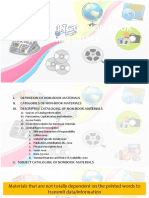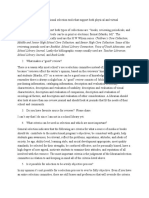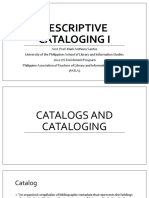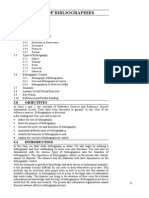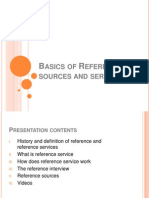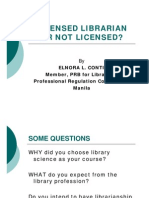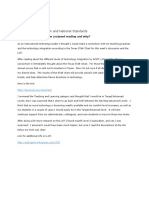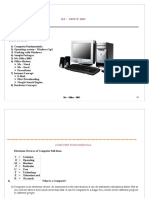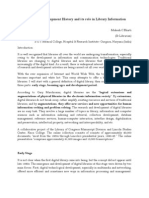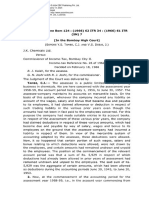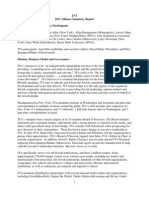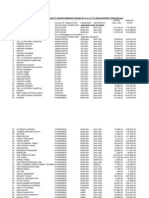IMD 301 Introduction To Cataloguing
IMD 301 Introduction To Cataloguing
Uploaded by
Khairunnisa JohariCopyright:
Available Formats
IMD 301 Introduction To Cataloguing
IMD 301 Introduction To Cataloguing
Uploaded by
Khairunnisa JohariOriginal Title
Copyright
Available Formats
Share this document
Did you find this document useful?
Is this content inappropriate?
Copyright:
Available Formats
IMD 301 Introduction To Cataloguing
IMD 301 Introduction To Cataloguing
Uploaded by
Khairunnisa JohariCopyright:
Available Formats
IMD 301
Introduction to Cataloguing
IMD 301 Introduction to Cataloguing 1.0 INTRODUCTION TO CATALOGUING 1.1 Cataloguing in context Cataloguing is a subset of the larger field of bibliographic control or organization of information. Catalogers, indexers, abstractors, bibliographers and information scientists establish bibliographic control over portions of the bibliographic universe. They create a bridge between the user and the many bibliographic tools available. The bibliographic tool created in the institutional library is the catalog. A catalog is an organized set of bibliographic records that represent the holding of a particular collection. Catalogs are necessary whenever a collection grows too large to be remembered. Objectives of catalog: to enable a person to find a book of which either the author, title or subject is known; to show what the library has; to assist in the choice of a book. Forms of catalogs: book catalog, card catalog, microform catalog, and online catalog. Characteristics of catalog: a catalog should be flexible and up-to-date; a catalog should be constructed so that all entries can be quickly and easily found; and a catalog should be economically prepared and maintained.
IMD 301
Introduction to Cataloguing
1.2 Library Catalog - A library catalog is a record or a list of the collection of a particular library, or of the collection of many libraries that are connected electronically. When it is a combined list of the holdings of many libraries, it is called a union catalog or a shared catalog. Basically, catalogs are established so that library users are able to retrieve the needed information. A good catalog is a good information delivery tool. To produce a good catalog, all materials must be catalogued. A library catalog is never complete because the library collection is a living institution. Materials are added on a daily basis as well as removed at regular intervals. To accurately reflect the collection of the library, it is necessary to update the catalog constantly.
1.3 Cataloguing - The process of organizing library materials and making them accessible to library users. Cataloguing work is divided into three parts: descriptive cataloguing, subject cataloguing and classification. 1.4 Descriptive Cataloguing Descriptive cataloguing is the cataloguing process that is concerned with the identification and description of an information package. This is the first step of the cataloguing process. This means describing the material physically and determining the choice of access point (headings). This is done by following the rules listed in the reference tool AngloAmerican Cataloguing Rules, Second Edition, 1998 Revision. (AACR2)
IMD 301
Introduction to Cataloguing
2.0 CATALOGUING OPERATIONS 2.1 Cataloguing Cataloguing is done in two ways: original cataloguing and copy cataloguing. Original cataloguing means that the entire process of cataloguing is completed locally by the library staff. In copy cataloguing, a shortcut is taken that entails copying the necessary information from a source that contains works already catalogued.
2.2 Original cataloguing Original cataloguing means that the cataloguing on an item is done by extracting the information needed for the bibliographic record from the material itself, plus using some standard tools to establish other necessary elements. The library cataloguing staff performs all the procedures to completely catalog materials. The tasks include descriptive cataloguing, and assigning subject headings, and classification numbers. Original cataloguing is divided into two broad areas, descriptive cataloguing and subject cataloguing. Subject cataloguing is done in two steps, subject heading and classification number.
2.3 Copy cataloguing The library staff copies or matches the cataloging information that is already completed by another cataloger from another library. If the record can be found from other catalogs or from any of the bibliographic utilities, the work of cataloguing is made easy by copying the existing information and inserting the needed local data.
IMD 301
Introduction to Cataloguing
Copy cataloguing is a widespread practice in the library world. It saves personnel, time, and money, resulting in speedier service while maintaining high quality. Information for copy cataloguing comes from different sources in the following: 2.3.1 Library of Congress 2.3.2 Cataloguing in Publication (CIP) 2.3.3 Bibliographic utilities and network 2.3.4 Printed sources
2.4 Shared Cataloguing The preparation by one of several participating agencies or libraries of a cataloguing record which is made available to the other participating agencies or libraries. Also called cooperative cataloguing or centralized cataloguing
IMD 301
Introduction to Cataloguing
3.0 DEVELOPMENT OF CATALOGUING CODES In the past years, cataloguing was the main activity in libraries. But each library has their own style in doing their cataloguing. So, there were many form and style of bibliographic records. Gradually, the librarian felt the need to standardize the records. The librarian also realized the benefits of the co-operation between the libraries and resource sharing; the result was benefit to all users. Since then, in the middle of 19th centuries, cataloguing network was produced. Each new code was improved. In 1839, Sir Anthony Panizzi was developed British Museum Cataloguing Rules @ Panizzis 91 Rules. It was as a guide for compilation of the British Museum catalogues. Its function as a list of inventory for easy retrieval. Cataloguing codes by Charles A. Jewett was developed in 1853. It consists of 33 rules for subject headings. Most of the rules were based on the Panizzis rules. It was the first rules for subject headings and were called as Jewetts Code. In 1876, Charles A.Cutter published Rules for a Printed Dictionary Catalogue 1st edition consist of 369 rules for descriptive cataloguing, subject headings and filing. It became the basis forms of the dictionary catalogue, which was to become the predominant form of catalogs in general libraries in the United States. Catalog Rules: Author and Title Entries. (AA 1908) represented the first joint effort between American and British librarians in developing a cataloging code. Prussian Instructions (PI) originally developed in 1908 as a standardized system of cataloging for Prussian libraries. Vatican Code rules were developed for the purpose of compiling a general catalog of printed books in the Vatican Library after its reorganization in the 1920s. Vatican Codes contains rules for entry, description, subject headings, and filing. Probably the most comprehensive and best-structured code at the time.
IMD 301
Introduction to Cataloguing
ALA Draft was developed in 1941, because there was a general feeling of the need for a revised ALA cataloging code by American Library Association. Its intention to cooperate with the Library Association of Great Britain and other national library associations. In 1946, the Library of Congress published its Studies of Descriptive Cataloging: A Report to the Librarian of Congress by the Director of the Processing Department, which advocated simplification of cataloging details. The Library of Congress proceeded to complete the work on the rules for description. A preliminary edition appeared in 1947, and a final edition appeared in 1949 and was called as LC 1949. Since the Library of Congress was revising its rules for description, the American Library Association also decided to improve the rules of ALA Draft. As a result the rules of ALA 1949 was launched. ALA 1949 and LC 1949 served as the standards for descriptive cataloging for American libraries until the appearance of the Anglo-American Cataloging Rules in 1967.
Anglo-American Cataloging Rules 1967 (AACR) was developed as a
result of the most important events in the evolution of cataloging codes. The International Conference on Cataloguing Principles was held in Paris, October 9-18, 1961, with delegations from 53 countries and 12 international organizations. They discussed on the principles of cataloging and in the year 1967, the new code appeared. By the year 1973, AACR was revised and completed in the year 1978.
The standards and agreement produced by Paris Conference and
International Meeting of Cataloging Experts played an important role in the revision of the AACR.
In 1988 Anglo-American Cataloging Rules, Second Edition 1988
(AACR2), was go through some revision related to a few rules for material such as computer files and music.
In 1998 the international committee of AACR2 again doing the revision for AACR2. This revision is important in enhancing the capability of AACR2 to cater description for any material that available. It was called as AngloAmerican Cataloguing Rules, Second edition, 1988 Revision (AACR2R).
IMD 301
Introduction to Cataloguing
For the purpose of consistency, AACR2R has adopted by most libraries in
the world. This book includes the rules that every library must follow when performing descriptive cataloging.
Besides the print edition, AACR2 is also available electronically on a CDROM titled AACR2R-e. AACR2R can also be found on a CD-ROM disk produced by the Library of Congress titled Catalogers Desktop
IMD 301
Introduction to Cataloguing
4.0 INTERNATIONAL STANDARD BIBLIOGRAPHIC DESCRIPTION (ISBD) The primary purpose of the ISBDs is to provide the stipulations for compatible descriptive cataloguing worldwide in order to aid the international exchange of bibliographic records between national bibliographic agencies and throughout the international library and information community. A standard that was designed to facilitate the international exchange of cataloging records by: i. Specifying the elements, which comprise a bibliographic description standardizing the elements to be used in the description. Prescribing the order in which those elements should be presented assigning and order to elements in ISBD The punctuation by which they should be demarcated specifying a system of symbols to be used in punctuating the elements.
ii.
iii.
The ISBDs aim to a. To standardize a bibliographic records for its contents, and information style - make records from different sources interchangeable, so that records produced in one country can be easily accepted in library catalogues or other bibliographic lists in any other country; b. To simplify the introduction of data records elements without concerning the language of the materials - assist in the interpretation of records across language barriers, so that records produced for users of one language can be interpreted by users of other languages; and c. To prepare and manipulation of bibliographic data in computer applications - Assist in the conversion of bibliographic records to electronic
IMD 301
Introduction to Cataloguing
Type of ISBDs ISBD(G) General international standard bibliographic description; ISBD(A) for older monographs (Antiquarian); ISBD(CM) for Cartographic Materials; ISBD(CF) for Computer Files; ISBD(M) for Monographic Publications; ISBD(NBM) for non-Book Materials; ISBD(S) for Serials;. ISBD(PM) for Printed Music;
ISBD contains eight (8) elements/areas: Area 1 Title and statement of responsibility Title proper assigned to the information package by persons responsible for its existence; name of individual or corporate bodies Area 2 Edition Statement about the version of the information packaged.
Area 3 Material (or type of publication) specific details Data about particular type of information package
Area 4 Publication, distribution, etc Name of the entity that is responsible for the presentation and packaging of the information package . Area 5 Physical description A physical description of an information package that is in tangible form.
IMD 301
Introduction to Cataloguing
Area 6 Series Title of any series of which the information package is part Area 7 Notes Added information to the description to provide useful information Area 8 Standard number and terms of availability The numbers recorded in this area are internationally agreed standard numbers. ISBN, ISSN.
10
IMD 301
Introduction to Cataloguing
5.0 CATALOGUING FOR LIBRARY MATERIALS 5.1 The structure of AACR2 1998 Revision (AACR2R98) - AACR2 is divided into two parts. The first part of AACR2 contains rules on the bibliographic description of library materials. These rules give instructions on how to represent the bibliographic and physical characteristics of the material being catalogued. Choice of access points, forms of headings, and cross-references are treated in Part Two of AACR2.
5.2 Description of materials using AACR2 5.2.1 Types of Library Materials For the purpose of bibliographic description, the following types of library materials have been identified in AACR2. Books, pamphlets, and printed sheet Cartographic materials Manuscripts Music Sound recordings Motion pictures and video recordings Graphic materials Electronic Resources Three-Dimensional Artifacts and Realia Microforms Continuing Resources Analysis
11
IMD 301
Introduction to Cataloguing
5.2.2 Organization of the Description The bibliographic description is divided into the following units, called areas, and presented in the order given: Title and statement of responsibility Edition Material (or type of publication) specific details Publication, distribution, etc Physical description Series Note(s) Standard number and terms of availability
5.2.3 Sources of Information AACR2 specifies sources of information to be used in describing a publication. It called as chief source of information The chief source of information is the source of bibliographic data to be given preference as the source from which a bibliographic description is prepared. The chief source of information may be unitary in nature or may be collective (entire material). For example, for a book, the chief source is the title page of the book. For a video recording, the chief source is the title frames or the information printed on its container.
Type of Material Books, pamphlets, printed sheets and Source Title page or its substitute
Cartographic materials (other than a printed atlas)
a. Cartographic item itself b. Container or case, the cradle and stand of a globe. Etc Manuscripts itself title page, colophon, caption, heading, etc, content of the manuscripts
Manuscripts
12
IMD 301
Introduction to Cataloguing
Music Sound recording - Disc - Tape (open reel-to-reel) - Tape cassette - Tape cartridge - Roll - Sound recording on film Motion pictures and video recordings Graphic materials
Title page or its substitute
Disc and label Reel and label Cassette and label Cartridge and label Label Container and label a. Item itself b. Its container (if integral of item)
Item itself, including any labels or the container Title screens or other formally presented internal evidence Object itself with any accompanying textual material and container Title frame Title page
Computer files
3D artifacts and realia
Microforms Continuing resources (serial)
5.2.4 Books, pamphlet and printed sheet (Ch.2) pg.2-1 5.2.5 Sound recording (Ch.6) pg 6.1 5.2.6 Continuing resources (ch.12) pg. 12.1
13
IMD 301
Introduction to Cataloguing
6.0 CHOICE OF ACCESS POINT (Ch.21) pg 21-1 6.1 Access Point Each bibliographic record is given one or more access points through which record can be retrieved. An access point is defined as a name, term, or code under which a bibliographic description is entered or filed in a catalog. Its presented in the form of a heading added to the description in a cataloging record. In manual catalogs, each heading applied to a record results in a separate catalog entry. In online catalogs, each access point constitutes a key with which a cataloging record maybe identified and retrieved. The four types of bibliographic access points found in catalog are: a. b. c. d. Names of persons who perform certain functions Names of corporate bodies Titles Names of series
6.2 Main Entry and Added Entry Access points include main and added entries. Each record has one main entry. All other access points are added entries. A record can have many added entries, using, as many terms as library users may need to find the record in the catalog.
6.3 Types of Main Entry The main entry of work is always a. A personal name entry, b. A corporate name entry, or c. A title entry.
14
IMD 301
Introduction to Cataloguing
Most book-form materials have main entry under personal authors, while many government publications are entered under corporate bodies. Serial publications and non-book materials usually have title main entries. a. Entry Under Personal Author 1. Single personal authorship For works of single authorship, entry is under the author. (Rule 21.4A) Examples: Islands in the stream / Ernest Hemingway A Benjamin Britten discovery / compiled by Charles H.Parsons Carmen [sound recording] / George Bizet.
2. Shared responsibility For works of shared responsibility, i.e., works produced by the collaboration of two or more persons who performed the same kind of activity such as writing, adapting, or performing. (rule 21.6B)
Examples: William S.Burroughs: a reference guide / Michael B.Goodman with Lemuel B.Coley (main entry under heading for Goodman; added entry under the heading for Coley)
Beyond ambition: how driven managers can lead better and live better / Robert E.Kaplan with Wilfred H.Drath and Joan R.Kofodimos (main entry under heading for Kaplan; added entries under headings for Drath and Kofodimos).
3. Mixed responsibility For works of mixed responsibility, i.e., previously existing works that have been modified (e,g.,adaptions, revisions, translations) and new works in which different persons or bodies performing different kinds of activity (e.g., collaborative work by a writer and an artist, reports of interviews, etc).
15
IMD 301
Introduction to Cataloguing
Examples: Gone with the wind, the screenplay / Sidney Horward; based on the novel by Margaret Mitchell (main entry under the heading for Howard; added entry under the heading for Mitchell). Bungalow fungalo / by Pegi Deitz Shea; illustrated by Elizabeth Sayles (Main entry under the heading for Shea; added entry under the heading for Sayles)
b. Entry Under Corporate Body Main entry under a corporate body is restricted to those works, which emanate from a corporate body. Examples: Annual report of the Director / Universiti Teknologi Mara Caw.Johor (main entry under the heading for Universiti Teknologi Mara Caw.Johor) Directory of members & services / Turnaround Management Association (main entry under the heading for Turnaround Management Association)
c. Entry Under Title By way of elimination, works that do not fall into the categories of works which require main entry under a person or a corporate body are entered under the title. In other words, a work is entered under title when:
16
IMD 301
Introduction to Cataloguing
i.
The personal authorship is unknown, diffuse or cannot be determined.
Examples: The role of national saving in the world economy: recent trends and prospects / by Bijan B.Aghevli[et.al] (main entry under title; added entry under the heading for Aghevli) The song of Roland / translated with an introduction and notes by Glyn Burgess (main entry under the uniform title for the song; added entry under the heading for Burgess)
ii.
It is a collection or a work produced under editorial direction that has a collective title. Examples: Reading in the middle school / Gerald G.Duffy, editor (main entry under title; added antery under the heading for Duffy). The performance of power: theatrical discourse and politics / edited by Sue-Allen Case and Janelle Reinelt (main entry under title; added entries under the headings for Case and Reinelt.)
iii.
It emanates from a corporate body but does not fall into any of the categories listed under rule 21.1B2 and not of personal authorship. Example: Journal of the Chemical Society. Faraday transaction / Royal Society of Chemistry (main entry under title; added entry under the heading for the societ) Nicholas of Cusa; in search of God and wisdom: papers from the American Cusanus Society / edited by Gerald Christianson and Thomas M.Izbicki (main entry under title; added entries under the headings for the society, Christianson, and Izbicki)
17
IMD 301
Introduction to Cataloguing
iv.
It is accepted as sacred scripture by a religious group. Example: The Old Testament (main entry under the uniform title for the Bible) Upanishads du yoga (main entry under the uniform title for Upanishads.
6.4 Added Entries In addition to the main entry heading, added entries are assigned to bibliographic records in order to provide additional access points through names and titles that are bibliographically significant. Added entries are generally made for potential access points not chosen as the main entry. They appear in the form of personal name headings, corporate name headings, titles, series, and name-titles headings. A name-title heading consists of the name heading of a person or corporate body and the title of an item, for example:
Faulkner, William, 1897-1962. Pylon.
6.5 Shelf list A file, either in card or book format or in the computer database, arranged in order by call numbers, showing the librarys holdings in shelf order. A file of cataloging records arranged by call number. The shelf list is used usually by library staff only for staff functions such as collection development or inventory control.
18
IMD 301
Introduction to Cataloguing
6.6 Tracing In library catalogs in the card or book form, the added entries are recorded in a paragraph called a tracing, which appears on the main entry record. In the tracing, each added entry is preceded by a roman numeral. Subject entries are preceded by Arabic numerals.
6.7 Indention -
They are two (2) types of indention. Normal indention precede headings under personal authors and corporate headings Hanging indention headings for under title or more than three (3) responsibilities or editor.
19
IMD 301
Introduction to Cataloguing
7.0 AUTHORITY CONTROL AND FORM OF HEADINGS
7.1 Authority control The control of access points by establishing and using consistent headings (list of all the authoritative access point) Authority control has three main purpose: i. To ensure that all works written by a particular author are retrievable with the same access point (or under the same heading) ii. To ensure that only works by that author are entered under a particular heading. iii. To save time and effort of having to establish the heading each time a work by the same author is catalogued.
7.2 Authority File Files of authorized names, series, titles, or subject heading (access point used in a catalog). The file is checked when doing cataloging to ensure consistency in the form of names, series titles, and subject headings. The card catalog or the OPAC database is usually need the authority file.
7.3 Forms of Headings After the main entry and added entries for a work have been determined, the next step is to decide in what form these entries are to be presented. Chapters 22 through 25 of AACR2 are devoted to the forms of headings to be used in catalog entries.
20
IMD 301
Introduction to Cataloguing
7.4 Headings for persons (Ch.22) pg 22-1 7.5 Heading for corporate bodies (Ch 24) pg 24-1 7.6 Uniform Titles
8.0 REFERENCES AND FILING RULES (CH.26) PG 26-1 8.1 See reference 8.2 See also reference 8.3 Name-title reference 8.4 Explanatory reference
21
IMD 301
Introduction to Cataloguing
9.0 MARC APPLICATION 9.1 MARC MARC stands for machine-readable cataloging. It consists of a system of inputting the cataloguing information on the computer following a standard devised by the Library of Congress. This standardize format allows other libraries to share the data, the computer to interpret the data, and users to retrieve the data. Bibliographic utilities and individual libraries that catalog on computers have adopted MARC.
9.2 Structure of AACR2 and of the MARC 21 format MARC 21 is a standard agreed upon by Canadian and United States representatives that prescribes a method for encoding bibliographic records so that they can be read by computer. Knowledge and understanding of the MARC format is essential for catalogers. Cataloguing record, based on AACR2 and MARC, with automation, computer can interpret the record. Then, these records can be share by other library system that contributing to the copy cataloging and online catalog.
22
You might also like
- History of CataloguingDocument16 pagesHistory of CataloguingRamota SakaNo ratings yet
- Library Organization and Management - With Laws, Related Practices, and Trends - 20%Document18 pagesLibrary Organization and Management - With Laws, Related Practices, and Trends - 20%FhcRojo0% (1)
- Cataloging of Non PrintDocument42 pagesCataloging of Non PrintJhein Subil GarayNo ratings yet
- Catalog in Card and MARC FormatDocument19 pagesCatalog in Card and MARC Formatmelgalon3840No ratings yet
- Library AcquisitionDocument4 pagesLibrary AcquisitionPia Eleanor Santos100% (1)
- Lis 524 Discussion 3Document2 pagesLis 524 Discussion 3api-236468899100% (1)
- Notes For Overview-I-Print Radio TV AdvertisingDocument133 pagesNotes For Overview-I-Print Radio TV AdvertisingArunNo ratings yet
- Styleitaliano Rubber Dam Perforations UPDATED ViaDocument6 pagesStyleitaliano Rubber Dam Perforations UPDATED ViablokolbNo ratings yet
- Union CatDocument9 pagesUnion CatDr. Muhammad SafdarNo ratings yet
- History of Catalogue CodesDocument15 pagesHistory of Catalogue CodesWikana MukangayiNo ratings yet
- Catalogue and CataloguingDocument37 pagesCatalogue and CataloguingUmair khlaidNo ratings yet
- DLIS 012 (Cat & C) Course MaterialDocument27 pagesDLIS 012 (Cat & C) Course MaterialFAIZA ALIYUNo ratings yet
- Introduction To ClassificationDocument21 pagesIntroduction To ClassificationMahamnoor100% (2)
- CatalogueDocument131 pagesCatalogueNyamanda ntonoNo ratings yet
- Cataloging NotesDocument33 pagesCataloging NotesAnnabelle ParedesNo ratings yet
- BLIS. Library Information ScienceDocument13 pagesBLIS. Library Information ScienceRam kumarNo ratings yet
- Part I: Descriptive Cataloging Test: Yadiyani 1Document13 pagesPart I: Descriptive Cataloging Test: Yadiyani 1April100% (1)
- Aacr2 Vs Rda FinalDocument9 pagesAacr2 Vs Rda Finalapi-291492035No ratings yet
- Lesson 7-Future of Reference and Information ServicesDocument12 pagesLesson 7-Future of Reference and Information ServicesGina May DaulNo ratings yet
- Technical and Information ServicesDocument26 pagesTechnical and Information ServicesdybsydollzNo ratings yet
- Introduction-to-Reference-and-Information-Services REPORTDocument33 pagesIntroduction-to-Reference-and-Information-Services REPORTeliNo ratings yet
- 11 - Blis Course Des PDFDocument2 pages11 - Blis Course Des PDFcnNo ratings yet
- Collection Development PolicyDocument11 pagesCollection Development PolicyDarwin BlasabasNo ratings yet
- LIBRARYDocument3 pagesLIBRARYSamantha Nicolle Quierra100% (2)
- Pre-Board Exam For Org, Management and Laws With Key AnswersDocument12 pagesPre-Board Exam For Org, Management and Laws With Key AnswersIan Alfonso San MartinNo ratings yet
- LIS 111 - Introduction To Records Mgt. and ArchivesDocument13 pagesLIS 111 - Introduction To Records Mgt. and ArchivesMitzi Portia VillanuevaNo ratings yet
- Pretest in Selection and AcquisitionDocument11 pagesPretest in Selection and Acquisitionnorhana.omalNo ratings yet
- Legal and Ethical Issues Surrounding Archives and Records ManagementDocument34 pagesLegal and Ethical Issues Surrounding Archives and Records Managementestradajoannamarie832No ratings yet
- Descriptive Cataloging IDocument167 pagesDescriptive Cataloging ISharmaine SorianoNo ratings yet
- The Importance of Marc in Information Retrieval and StorageDocument16 pagesThe Importance of Marc in Information Retrieval and StorageSiti Nabila Zawawi100% (5)
- Block 3 MLI 101 Unit 12Document29 pagesBlock 3 MLI 101 Unit 12ravinderreddynNo ratings yet
- Collection: Ollection Centered EchniquesDocument8 pagesCollection: Ollection Centered EchniquesHellenNdegwaNo ratings yet
- Reference and Information Sources UnitDocument15 pagesReference and Information Sources UnitnagasmsNo ratings yet
- Forms of AbstractsDocument9 pagesForms of AbstractsNiyonzimaNo ratings yet
- Modern Library and Information Science S PDFDocument318 pagesModern Library and Information Science S PDFvarshaNo ratings yet
- Library and Information ScienceDocument16 pagesLibrary and Information ScienceRupesh Kumar A100% (1)
- Basics Reference Source and ServicesDocument32 pagesBasics Reference Source and ServicesJoseph Marmol Yap100% (2)
- Indexingand Abstracting ServicesDocument27 pagesIndexingand Abstracting ServicesMohammad NasirNo ratings yet
- LlICENSED (Compatibility Mode)Document17 pagesLlICENSED (Compatibility Mode)mshslibraryNo ratings yet
- Collection Development PolicyDocument6 pagesCollection Development PolicyginamsheltonNo ratings yet
- Notation: by Shivam MoradiaDocument23 pagesNotation: by Shivam MoradiashivamNo ratings yet
- 2019 PUP LLE Review - Reference (40 Items)Document5 pages2019 PUP LLE Review - Reference (40 Items)Mabel Motocan100% (3)
- WEEK 4 - The CatalogDocument29 pagesWEEK 4 - The CatalogINTAN NURHAZWANINo ratings yet
- LIS 105 Detailed Teaching SyllabusDocument8 pagesLIS 105 Detailed Teaching SyllabusMerry Kris Egargue0% (1)
- The Pioneer of Reference ServicesDocument12 pagesThe Pioneer of Reference ServicesFlorabeth Graciella Bustamante Tanda100% (1)
- Trends in Library Classification PDFDocument14 pagesTrends in Library Classification PDFPriyank SinghNo ratings yet
- 9 Igcse Physics Sa2 Paper4Document15 pages9 Igcse Physics Sa2 Paper4prasanna reddyNo ratings yet
- An Overview of Special Library ManagementDocument3 pagesAn Overview of Special Library ManagementGrace CastañoNo ratings yet
- Archival Principles Respect Des Fonds and Principe de ProvenanceDocument2 pagesArchival Principles Respect Des Fonds and Principe de ProvenanceṦAi Dį100% (1)
- Code of Ethics For Philippine LibrariansDocument2 pagesCode of Ethics For Philippine LibrariansVerz Jaminal100% (4)
- An Assignment On LibraryDocument11 pagesAn Assignment On LibraryLakshmivinod89100% (1)
- Corazon M. Nera Director of Libraries, Lyceum of The Philippines Member, Board of Librarians, PRCDocument38 pagesCorazon M. Nera Director of Libraries, Lyceum of The Philippines Member, Board of Librarians, PRCcrizarah100% (1)
- 7 Pages Exams Library Laws & PracticesDocument8 pages7 Pages Exams Library Laws & PracticesMichelle AbellaNo ratings yet
- ETEC 579 Discussion 5Document2 pagesETEC 579 Discussion 5Kristin McCloskeyNo ratings yet
- Classification Library Mgmt.Document43 pagesClassification Library Mgmt.sanamar_1980No ratings yet
- Computer FundamentalsDocument84 pagesComputer FundamentalsSai RamNo ratings yet
- Cataloging and Classification of Books-1Document48 pagesCataloging and Classification of Books-1Joseph Villimore GeronimoNo ratings yet
- Digital Library Development History and Its Role in Library Information Science: Mukesh C.bhartiDocument6 pagesDigital Library Development History and Its Role in Library Information Science: Mukesh C.bhartiMukesh C BhartiNo ratings yet
- Canons For ClassifIcationDocument22 pagesCanons For ClassifIcationMohan ThallaNo ratings yet
- UNIT 1 - Reference and Information SourcesDocument14 pagesUNIT 1 - Reference and Information SourcesDean Jerick IgayaNo ratings yet
- Library SciDocument10 pagesLibrary Sciaakashverma3012No ratings yet
- Cataloging and ClassificationDocument140 pagesCataloging and ClassificationSu Jun MEj DaEnchu100% (1)
- Prospect and Challenges of Basic Chemicals Industries in BangladeshDocument7 pagesProspect and Challenges of Basic Chemicals Industries in BangladeshAsiful IslamNo ratings yet
- Ripperologist 91Document91 pagesRipperologist 91CustardScreamNo ratings yet
- J.K Chemicals Vs CIT (1966) Bom HCDocument8 pagesJ.K Chemicals Vs CIT (1966) Bom HCishaankc1510No ratings yet
- Albuquerque's Best Alternative Newspaper - ABQ Free Press 2-8-15 - News, Analysis, Arts and EntertainmentDocument13 pagesAlbuquerque's Best Alternative Newspaper - ABQ Free Press 2-8-15 - News, Analysis, Arts and EntertainmentFreeABQNo ratings yet
- Font Testing DocumentDocument2 pagesFont Testing Documentapi-335556404No ratings yet
- Forms of LiteratureDocument19 pagesForms of LiteratureRona Nogales0% (1)
- INDS 702 A01 INDS Seminar1 Fall 2014 Preethi Hannah SCAD - Atlanta Professor CulpepperDocument31 pagesINDS 702 A01 INDS Seminar1 Fall 2014 Preethi Hannah SCAD - Atlanta Professor CulpepperPreethi HannahNo ratings yet
- Commodore Magazine Vol-10-N01 1989 JanDocument132 pagesCommodore Magazine Vol-10-N01 1989 JanSteven DNo ratings yet
- Campus Journalism: CopyeditingDocument34 pagesCampus Journalism: CopyeditingKhristel Alcayde100% (2)
- I A Private Conversation: AnswerDocument8 pagesI A Private Conversation: AnswerDiana AnghelacheNo ratings yet
- Holiday Homework Class 8Document4 pagesHoliday Homework Class 8actllkitchencornerNo ratings yet
- Mary Ellen Mark - The Photo Essay PDFDocument8 pagesMary Ellen Mark - The Photo Essay PDFAna MunozNo ratings yet
- PepsicoDocument17 pagesPepsicoUsman GhaniNo ratings yet
- The National Federation/Agency Alliance - 2011 JTA Summary ReportDocument7 pagesThe National Federation/Agency Alliance - 2011 JTA Summary ReportJoel Alan KatzNo ratings yet
- March 21 - 27, 2018 Sports ReporterDocument8 pagesMarch 21 - 27, 2018 Sports ReporterSportsReporterNo ratings yet
- BiggDocument6 pagesBiggsita nurmatus salmaNo ratings yet
- Redwedgebroc 1Document2 pagesRedwedgebroc 1api-223870209No ratings yet
- John Daniels Resume 2 PDFDocument1 pageJohn Daniels Resume 2 PDFAndy ReevesNo ratings yet
- Self-Help - Thirty Things Every Woman Should Have and Should KnowDocument125 pagesSelf-Help - Thirty Things Every Woman Should Have and Should KnowPallavi DhingraNo ratings yet
- Qing.: MagazineDocument40 pagesQing.: MagazineMatthew Walker100% (1)
- Referencing Leaflet 2013Document2 pagesReferencing Leaflet 2013Ulfathbary ABNo ratings yet
- Direct and Reported Speech QuizDocument2 pagesDirect and Reported Speech QuizMerry Grace Patrena SibalNo ratings yet
- Unofficial Rules Cyclopedia CompanionDocument326 pagesUnofficial Rules Cyclopedia CompanionNewpasswordhere NewpasswordhereNo ratings yet
- MIB Annual Report 2010-11 Part-IIDocument264 pagesMIB Annual Report 2010-11 Part-IIrajeswarraopatloriNo ratings yet
- Producing Feminized Seeds Using Colloidal SilverDocument15 pagesProducing Feminized Seeds Using Colloidal SilverathosNo ratings yet
- Journal of Musicological Research Volume 31 Issue 4 2012 (Doi 10.1080/01411896.2013.720917) Bungert, James - Richard Cohn, Audacious Euphony - Chromaticism and The Triad's Second NatureDocument5 pagesJournal of Musicological Research Volume 31 Issue 4 2012 (Doi 10.1080/01411896.2013.720917) Bungert, James - Richard Cohn, Audacious Euphony - Chromaticism and The Triad's Second NatureOracularOeuvre100% (1)
- Papercraft Toy Series: (Section 1) ExperimentsDocument5 pagesPapercraft Toy Series: (Section 1) ExperimentsejoorooNo ratings yet
- 101 Best Websites For Writers 2014 PDFDocument9 pages101 Best Websites For Writers 2014 PDFTon Nogueira100% (1)


